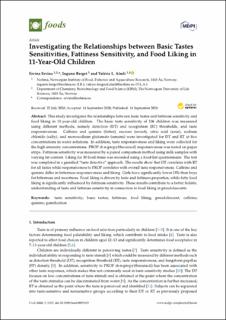Investigating the Relationships between Basic Tastes Sensitivities, Fattiness Sensitivity, and Food Liking in 11-Year-Old Children
Peer reviewed, Journal article
Published version
Permanent lenke
https://hdl.handle.net/11250/2829470Utgivelsesdato
2020Metadata
Vis full innførselSamlinger
Originalversjon
10.3390/foods9091315Sammendrag
This study investigates the relationships between basic tastes and fattiness sensitivity and food liking in 11-year-old children. The basic taste sensitivity of 106 children was measured using different methods, namely detection (DT) and recognition (RT) thresholds, and taste responsiveness. Caffeine and quinine (bitter), sucrose (sweet), citric acid (sour), sodium chloride (salty), and monosodium glutamate (umami) were investigated for DT and RT at five concentrations in water solutions. In addition, taste responsiveness and liking were collected for the high-intensity concentrations. PROP (6-n-propylthiouracil) responsiveness was tested on paper strips. Fattiness sensitivity was measured by a paired comparison method using milk samples with varying fat content. Liking for 30 food items was recorded using a food-list questionnaire. The test was completed in a gamified “taste detective” approach. The results show that DT correlates with RT for all tastes while responsiveness to PROP correlates with overall taste responsiveness. Caffeine and quinine differ in bitterness responsiveness and liking. Girls have significantly lower DTs than boys for bitterness and sweetness. Food liking is driven by taste and fattiness properties, while fatty food liking is significantly influenced by fattiness sensitivity. These results contribute to a better holistic understanding of taste and fattiness sensitivity in connection to food liking in preadolescents.
